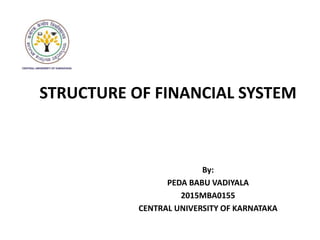
structure of financial system
- 1. STRUCTURE OF FINANCIAL SYSTEM By: PEDA BABU VADIYALA 2015MBA0155 CENTRAL UNIVERSITY OF KARNATAKA
- 2. Financial System • A financial system functions as an intermediary between savers and investors. It facilitates the flow of funds from the areas of surplus to the areas of deficit. It is concerned about the money, credit and finance. • A financial system may be defined as a set of institutions, instruments and markets which promotes savings and channels them to their most efficient use. It consists of individuals (savers), intermediaries, markets and users of savings (investors).
- 4. Financial Institutions • They are business organizations dealing in financial resources. • They collect resources by accepting deposits from individuals and institutions and lend them to trade, industry and others. • This means financial institutions mobilize the savings of savers and give credit or finance to the investors.
- 5. On the basis of the nature of activities, financial institutions may be classified as: 1.Banking financial institutions • Banking institutions mobilize the savings of the people. • They provide a mechanism for the smooth exchange of goods and services. • They extend credit while lending money. • They not only supply credit but also create credit.
- 6. Contd.. 2. Non-banking financial institutions • The non-banking financial institutions also mobilize financial resources directly or indirectly from the people. • They lend funds but do not create credit. Companies like LIC, GIC,UTI, Development Financial Institutions. • Non-banking financial institutions can be categorized as investment companies, housing companies, leasing companies, hire purchase companies, specialized financial institutions
- 7. Financial Markets • Financial markets are the centres or arrangements that provide facilities for buying and selling of financial claims and services. • Financial markets exist wherever financial transactions take place. • Financial transactions include issue of equity stock by a company, purchase of bonds in the secondary market, deposit of money in a bank account, transfer of funds from a current account to a savings account etc.
- 8. Classification on the basis of the type of financial claim: 1.Debt market: The debt market is the financial market for fixed claims like debt instruments 2.Equity Market: The equity market is the financial market for residual claims i.e., equity instruments
- 9. Classification on the basis of maturity of claims: 1. Money markets • A market where short term funds are borrowed and lend is called money market. • It deals in short term monetary assets with a maturity period of one year or less. 2. Capital Markets • Capital market is the market for long term funds. • This market deals in the long term claims, securities and stocks with a maturity period of more than one year.
- 10. Classification on the basis of seasoning of claim: 1. Primary markets • Primary markets are those markets which deal in the new securities. • Therefore, they are also known as new issue markets. • These are markets where securities are issued for the first time. 2. Secondary market • Secondary markets are those markets which deal in existing securities. • Existing securities are those securities that have already been issued and are already outstanding. • Secondary market consists of stock exchanges.
- 11. Classification on the basis of structure or arrangements: 1.Organized markets • These are financial markets in which financial transactions take place within the well established exchanges or in the systematic and orderly structure. 2. Unorganized markets. • These are financial markets in which financial transactions take place outside the well established exchange or without systematic and orderly structure or arrangements.
- 12. Classification on the basis of timing of delivery: 1.Cash/spot market • This is the market where the buying and selling of commodities happens or stocks are sold for cash and delivered immediately after the purchase or sale of commodities or securities. 2. Forward/future market • This is the market where participants buy and sell stocks/commodities, contracts and the delivery of commodities or securities occurs at a pre- determined time in future.
- 13. Other types of financial market: 1. Foreign exchange market: Foreign exchange market is simply defined as a market in which one country’s currency is traded for another country’s currency. It is a market for the purchase and sale of foreign currencies. 2. Derivatives market: The derivatives are most modern financial instruments in hedging risk. The individuals and firms who wish to avoid or reduce risk can deal with the others who are willing to accept the risk for a price. A common place where such transactions take place is called the derivative market.
- 14. Financial Instruments Which are used for raising resources for corporate activities That are used for raising capital through the capital market are known as ‘capital market instruments’. Example: Preference shares, equity shares, warrants, debentures and bonds.
- 15. Contd.. That are used for raising and supplying money in short period not exceeding one year through various securities are called ‘money market instruments’. Example: treasure bills, gilt-edge securities, state government and public sector instruments, commercial paper, commercial bills etc.
- 16. Financial Services • The development of a sophisticated and matured financial system in the country, especially after the early nineties, led to the emergence of a new sector. • This new sector is known as financial services sector. Its objective is to intermediate and facilitate financial transactions of individuals and institutional investors. • The financial institutions and financial markets help the financial system through financial instruments.
- 17. Contd.. • The financial services include all activities connected with the transformation of savings into investment. • Important financial services include lease financing, hire purchase, installment payment systems, merchant banking, factoring, forfaiting etc.
